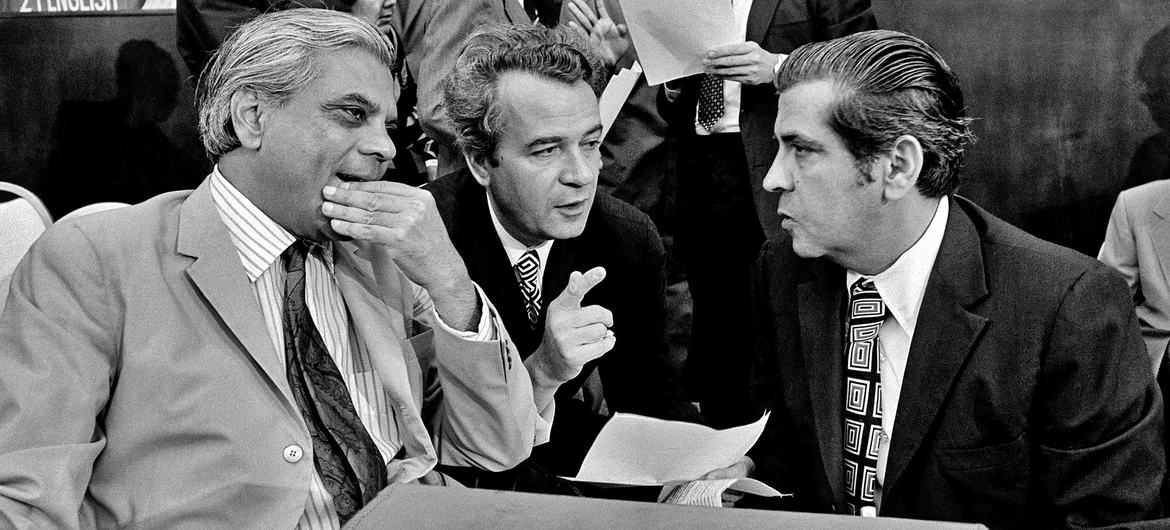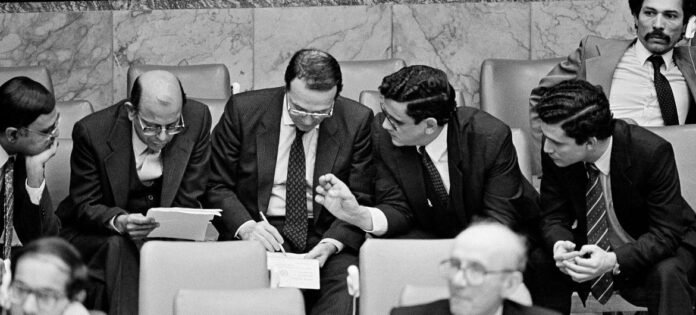The UN Security Council, which consists of 15 member states, is responsible for dealing with threats to international peace and security through resolutions and decisions and taking necessary action.
These resolutions are legally binding on the 193 member states of the United Nations, but sometimes the passage of drafts of such documents is beset by many challenges.
Since the Gaza war began in October 2023, members of the Security Council have drafted, debated and then adopted a number of resolutions.
But many such drafts and amendments have also surfaced, which have been rejected or vetoed due to insufficient votes (9 votes) in the Security Council.
The five permanent members of the United Nations – China, France, Russia, Britain, America – have a special right of veto, through which any proposal can be stopped.
Sometimes, because of certain words, verbs or adjectives in the proposal, this process stalls, after which member states engage in bargaining to adopt their positions.
For example, in the Gaza Strip, some suggestions referred to ‘ceasefire’, while others wanted to use ‘cessation of hostilities’.
And then, sometimes the Security Council does not reach consensus.
Whenever a permanent member state exercises its veto power, a new procedure is triggered, which Liechtenstein introduced in 2022.
Under this, after using the veto power, the President of the United Nations General Assembly can call an emergency special session of the General Assembly or a formal meeting of the members of the United Nations on that controversial issue.
In 1984, representatives of India, Egypt and Nicaragua held informal talks before the Security Council began meeting.
Another way is through the ‘Uniting for Peace’ resolution, according to which, if the Security Council fails to fulfill its responsibility to maintain international peace and security, then an emergency special session of the General Assembly can be called.
11 emergency special sessions have been called so far. The proposal named ‘Uniting for Peace’ has been implemented 13 times from 1951 to 2022. The Security Council has adopted this measure eight times and the General Assembly five times, in 11 of which emergency special sessions have been convened.
In 1946, the Security Council passed the first resolution establishing the United Nations Military Staff Committee.
Since then, the proposal drafting process has remained largely unchanged.
We’ve gathered information for you on the proposal’s journey from concept to becoming a legally binding document for 193 member states.
First step
In this process, a preliminary draft of any proposal is first prepared, which may be co-sponsored by one or more member countries.
Drafting initial solutions to a crisis like Gaza is a comprehensive process. According to Nikolai Galkin, a senior official in the Security Council affairs department at UN headquarters, other countries besides the 15 members of the council may also participate in the process.
A first step in these directions is taken by counselors working in permanent missions of UN member states who have expertise in this area.

In 1973, after receiving a second draft of the resolution in Latin America, representatives of Pakistan, the former Yugoslavia and Panama held talks before the meeting began. (file)
They consult with delegations of Security Council member states, as well as regional groups, concerned countries and other key stakeholders.
Their goal is to pass any resolution, either unanimously or by majority, for actions such as ending violent conflict, authorizing peacekeeping missions, imposing sanctions or referring a case to the International Court of Justice.
All these measures are consistent with the responsibilities of the Security Council under the UN Charter. At this stage, the drafting or sponsoring countries try to unite as many voices as possible.
‘zero’ draft
After this, the initial concept is transformed into a ‘zero draft’ of the proposal.
According to senior political affairs officer Nikolai Galkin, it is not a complete draft at this point, but is largely ready for comments by council members.
A revised version of the proposal was then developed based on that.
Once the ‘zero draft’ is created, it is often sent via email. By country drafting the resolution, members are requested to provide suggestions, which are collected via email, in person or WhatsApp messages.
Negotiation and compromise
There is disagreement in this process. The UAE prepared a ‘zero draft’ on the Gaza issue in December 2023. There was much disagreement over the reference to the ‘ceasefire’, which remained in the news.
Some countries were in favor while other delegations opposed the inclusion of this term in the resolution.

A document providing information on three meetings of the Security Council. (file)
Usually an attempt is made to resolve mutual differences through negotiation. These do not happen at UN headquarters. Occasionally, a room is reserved for ‘informal’ discussions just a few steps away from the Security Council chamber.
It is also possible that member states could draft a resolution in their capitals instead of New York.
What is written in blue ink?
After one or more rounds of discussion or negotiations, member countries share the final draft with other members. In the case of the UAE, the draft resolution on Gaza was also sent to other UN members outside the Security Council, as is sometimes done.
Within 24 hours, 97 member states had co-sponsored it.
At this stage, the revised draft is assigned a document number and the written content is prepared in a proper format.
It is then published in blue ink and emailed to council members.
Before the COVID-19 pandemic, draft resolutions were printed in blue ink and then distributed to each council member’s seat and to the chamber’s document counter.
To protect the environment, these drafts are now emailed to member states rather than printed, although they are written in blue ink.
But why blue ink?
The reason for this is hidden in a decades-old photocopy machine kept in a corner of the Security Council office.
These drafts were printed with this machine for 15 member countries and only blue ink was available at the time.
At one time, publication in blue ink signaled that the Security Council was ready to take action, and a meeting was often called within 24 hours.

US Ambassador Linda Thomas-Greenfield abstained from voting on the Security Council resolution on the Middle East situation.
Votes and vetoes
In a formal, open meeting of the Security Council, member states gather around a horseshoe table in the Security Council chamber. The country holding the monthly presidency of the Security Council requests a vote after the session begins.
Some members may make a statement before casting their vote, expressing their delegation’s position or objection. Amendments are often submitted to draft proposals.
And then, comes the result time.
“Raise your hand for that.” This is said by the President of the Security Council, after which the representatives sitting around the table vote for or against the resolution. Sometimes member states do not participate in the vote.
At least 9 votes are required to pass a resolution, but only if no permanent member exercises the right of veto.
The President of the Security Council then reports the results of the vote and the draft is either adopted or rejected.
Blue to black ink
The final step in this process is to send the final draft of the document to the other parties and translate it into the six official UN languages - Arabic, Chinese, English, French, Russian and Spanish. These are published in black ink.
All resolutions passed or rejected are numbered and then become part of the UN documentation system.
Nikolai Galkin said, after a few months, trying to find the draft of these proposals on the website of the UN Security Council.

